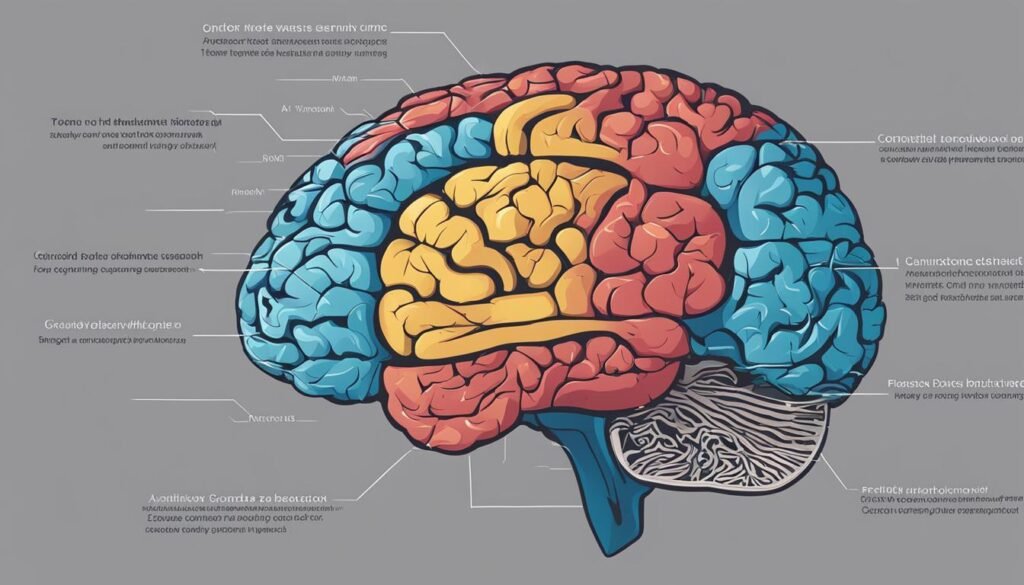Dog behavior can sometimes be puzzling, especially when it seems like your furry friend is ignoring you. It’s important to understand that there are reasons behind this behavior and ways to improve the communication between you and your dog.
In order to gain your dog’s trust and improve their responsiveness, it’s helpful to delve into the psychology of dogs and learn effective communication techniques. By understanding how dogs think and communicate, you can strengthen your bond with your pet and create a more harmonious relationship.
Key Takeaways:
- Understanding dog behavior is crucial for improving communication with your furry friend.
- Gaining your dog’s trust is essential for a strong and responsive relationship.
- Learning effective communication techniques, based on dog psychology, can help you overcome the challenge of being ignored.
- Patience, consistency, and understanding are key when working towards better communication with your dog.
- By building a solid foundation of trust and using positive reinforcement, you can enhance your dog’s attentiveness and willingness to listen.
The Importance of Understanding Dog Language
Dogs have their own unique way of communicating, and it’s primarily through visual cues rather than verbal language. They rely on their posture, tail position, eye contact, and ear movements to convey messages. As a result, constant talking can be overwhelming and confusing for dogs.
To effectively communicate with your dog, it’s crucial to understand their visual language and adjust your communication accordingly. By paying attention to their body language and nonverbal cues, you can better interpret their emotions and intentions. For example, a wagging tail can indicate happiness or excitement, while a tucked tail may signal fear or anxiety.
It’s also important to note that different breeds may have variations in their body language, so it’s essential to familiarize yourself with your dog’s specific breed traits. Being attuned to their visual communication will enable you to establish a stronger connection and bond with your furry friend.
Nonverbal cues to look out for:
- Posture: A relaxed, loose body posture indicates comfort and ease, while a stiff or crouched posture may indicate fear or aggression.
- Tail position: The position and movement of the tail can convey various emotions, from happiness and excitement to fear or defensiveness.
- Eye contact: Direct eye contact can be seen as a sign of assertiveness or dominance, while avoiding eye contact may indicate submission or fear.
- Ear movements: Ears held forward and alert signify attentiveness, while flattened or pinned-back ears can indicate fear or discomfort.
“Understanding dog language is key to effective communication and building trust with your furry friend.”
The Role of Timing in Dog Training
Timing plays a critical role in dog training, influencing the effectiveness of behavior reinforcement and the consequences of a dog’s actions. Dogs live in the present moment and respond to immediate feedback, making it essential to provide timely rewards and corrections.
When training your dog, it’s important to reward desired behaviors promptly. This reinforces the connection between the action and the positive outcome, allowing your dog to understand what is expected of them. Delayed rewards can lead to confusion and a lack of responsiveness, as the dog may not associate the reward with the desired behavior.
Similarly, timely corrections are necessary when a dog displays undesirable behavior. Immediate feedback helps the dog understand that their actions have negative consequences. However, it’s important to ensure that corrections are fair and consistent, focusing on redirecting the behavior rather than punishing the dog.
“In dog training, timing is everything. It’s crucial to provide immediate feedback to reinforce desired behaviors and correct undesirable ones. Proper timing enhances the dog’s understanding of our expectations and promotes a positive training experience,” says dog training expert, Dr. Sarah Johnson.
By mastering the art of timing, you can create clear communication channels with your dog and improve their responsiveness during training sessions. Remember to be consistent and patient, as timing is an ongoing process that requires practice and observation of your dog’s behavior.
Addressing Context-Specific Training
When it comes to training our furry companions, it’s important to understand that dogs are highly context-specific learners. This means that they need to be trained in various environments to generalize their skills. Just because a dog obeys commands in one setting doesn’t mean they will automatically respond in a different context.
Context-specific training refers to the process of teaching a dog to perform a behavior in different situations and environments. It involves gradually exposing the dog to new locations, distractions, and scenarios to ensure that they understand and respond to commands consistently.
Generalization in training is an essential aspect of addressing context-specific learning. It involves teaching dogs to transfer their learned behaviors from one context to another. For example, if your dog can sit on command at home, generalization training would involve teaching them to sit when you’re out for a walk or visiting friends.
Training in Different Environments
To effectively address context-specific training and promote generalization, it’s important to introduce your dog to various environments during the training process. Here are some tips to consider:
- Start with low-distraction environments and gradually increase the level of distraction as your dog becomes more comfortable and responsive
- Expose your dog to different sounds, smells, and sights to help them become familiar with new stimuli
- Practice commands and behaviors in different locations, such as parks, streets, and friends’ houses, to reinforce their understanding in various settings
- Use positive reinforcement techniques, such as treats and praise, to reward your dog for responding to commands in different environments
By consistently practicing training in different environments and gradually increasing the level of difficulty, you can help your dog generalize their learned behaviors. Remember to be patient, consistent, and positive throughout the training process, and celebrate their successes along the way.
Medical Reasons for Ignoring Behavior
While there are various reasons why a dog may appear to be ignoring their owner, it’s important to consider that there could be underlying medical causes. Two common medical factors that can contribute to ignoring behavior in dogs are hearing loss and depression.
Just like humans, dogs can experience hearing loss due to a variety of reasons. A ruptured eardrum or chronic ear infections can impair a dog’s ability to hear commands and verbal cues, leading to a perceived disregard for their owner’s communication. It’s essential to have your dog’s hearing evaluated by a veterinarian if you suspect hearing loss may be a contributing factor.
Additionally, dogs can suffer from depression, which can significantly impact their overall energy levels and willingness to engage with their owner. Just like humans, dogs can experience feelings of sadness, loss, or lethargy, which can lead to a lack of responsiveness. If your dog is displaying signs of depression, such as decreased appetite, lack of interest in activities, or excessive sleeping, it’s important to consult with a veterinarian to address their emotional well-being.
Understanding and addressing these medical causes can help dog owners better support their pets and improve their responsiveness. By seeking veterinary care and addressing any underlying medical issues, you can ensure that your dog receives the necessary treatment and support to thrive.

Summing it up:
- Hearing loss and depression are two common medical causes of ignoring behavior in dogs.
- Ruptured eardrums or chronic ear infections can impair a dog’s hearing and lead to miscommunication.
- Depression in dogs can result in decreased energy levels and a lack of interest in engaging with their owner.
- Consulting with a veterinarian is essential to address and treat these medical causes.
Training Techniques and Building Trust
When it comes to training your dog, employing the right techniques is essential for building a strong bond and fostering effective communication. Consistency is key in reinforcing positive behaviors and teaching your dog what is expected of them. By using rewards and praise, you can motivate your dog and create a positive association with learning and obeying commands.
Positive reinforcement is a powerful tool in dog training. By rewarding your dog for desired behaviors, such as sitting or coming when called, you reinforce the idea that obeying commands leads to pleasant outcomes. This approach helps to build trust between you and your dog, as they learn that following your instructions leads to positive experiences.
In addition to consistency and positive reinforcement, clear communication is vital in training your dog effectively. Dogs are sensitive to body language and tone of voice, so it’s important to be consistent in your cues and vocal intonations. Use a clear and distinct voice when giving commands, and be mindful of your body language, as dogs are keen observers of human behavior.
Training Tips:
- Start with basic commands like sit, stay, and come. These are fundamental cues that lay the foundation for more advanced training.
- Use hand signals in conjunction with verbal commands. This helps to reinforce the desired behavior and provides a visual cue that your dog can understand.
- Keep training sessions short and frequent. Dogs have limited attention spans, so short, focused sessions are more effective than long, drawn-out ones.
- Be patient and consistent. Dogs learn at their own pace, so it’s important to remain patient and reinforce desired behaviors consistently over time.
Remember, building trust and effective communication takes time and effort. By using positive reinforcement, consistent training techniques, and clear communication, you can strengthen your bond with your dog and improve their responsiveness to your commands.
The Freedom to Ignore and Focusing on Important Commands
When it comes to communication with our dogs, it’s essential to understand that they have the freedom to ignore certain cues or commands. Dogs have selective attention, meaning they prioritize what they perceive as important and relevant to their needs. Therefore, it’s crucial for us as dog owners to focus on teaching and reinforcing essential commands that promote their safety, well-being, and overall good behavior.
To ensure that our dogs pay attention when it matters most, we should prioritize commands that are crucial for their safety and the well-being of those around them. Recall commands, such as “come” or “here,” are vital for off-leash control and preventing dangerous situations. Safety cues like “stop” or “stay” can prevent our dogs from running onto busy roads or approaching potentially aggressive dogs. By consistently working on these essential commands, we can help our dogs develop a strong understanding of what is expected of them in critical situations.
It’s important to keep in mind that while we may want our dogs to respond to every cue, overwhelming them with too many commands can lead to confusion and a lack of responsiveness. Instead, we should focus on clear and consistent communication, reinforcing the most important commands through positive reinforcement and rewards. By doing so, we establish a stronger relationship with our dogs and build trust, ensuring that they pay attention when it matters most.
Key Points:
- Dogs have selective attention and prioritize what they perceive as important.
- Prioritize essential commands that promote safety and well-being.
- Commands such as recall and safety cues are crucial for off-leash control and preventing dangerous situations.
- Clear and consistent communication, along with positive reinforcement, helps build trust and responsiveness.

By focusing on important commands and avoiding information overload, we can ensure that our dogs pay attention when it matters most.
Conclusion
Understanding why your dog ignores you is the first step towards building a stronger dog-owner relationship. Effective communication is key to gaining your dog’s attention and trust. By learning their visual language, adapting your timing in training, and using the right techniques, you can improve responsiveness and create a deeper bond with your furry friend.
Remember, patience and consistency are essential. Training your dog takes time, but by providing clear communication and positive reinforcement, you can enhance their attentiveness and willingness to listen. Focus on important commands and prioritize communication that matters most to ensure your dog pays attention when needed.
By investing in effective communication and building trust, you can create a harmonious relationship with your dog. Strengthening the bond between you and your pet will not only improve their responsiveness but also enhance the overall quality of your interactions. So, keep practicing and enjoy the journey of understanding and connecting with your beloved dog.
FAQ
Why does my dog sometimes ignore me?
Dogs have their own unique way of communicating, primarily through visual cues. Constant talking can be overwhelming and confusing for dogs. Understanding their visual language and adjusting your communication accordingly can improve responsiveness.
How does timing affect dog training?
Dogs live in the present moment, and their behavior is influenced by immediate consequences. Providing timely rewards and feedback is crucial to reinforce desired behaviors. Delayed or inconsistent feedback can lead to confusion and a lack of responsiveness.
Can my dog’s training generalize to different environments?
Dogs are context-specific learners. Training in various settings is necessary to generalize their skills. Dogs may not fully understand commands in unfamiliar contexts and may need additional training and reinforcement.
Could my dog’s ignoring behavior be due to medical reasons?
Yes, underlying medical reasons such as hearing loss or depression can affect a dog’s responsiveness. Considering potential medical factors is essential when trying to understand why your dog may be ignoring you.
How can I strengthen my relationship with my dog through training?
Consistency, positive reinforcement, and clear communication are key factors in building trust and promoting responsiveness. Establishing a solid foundation of trust and using effective training methods can improve your dog’s willingness to listen.
Why do dogs have the freedom to ignore certain communications?
Dogs prioritize what they consider essential. Focusing on training and reinforcing important commands, such as recall and safety cues, ensures that your dog pays attention when it matters most.

